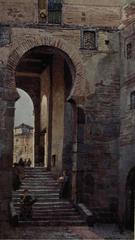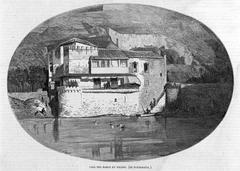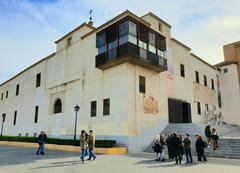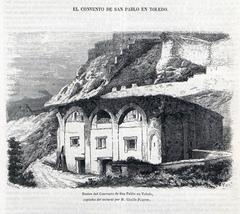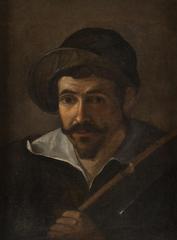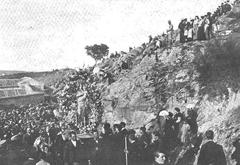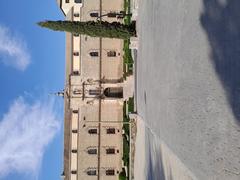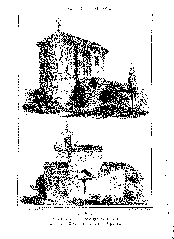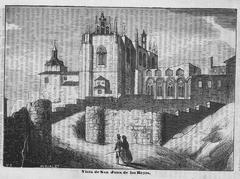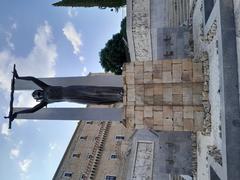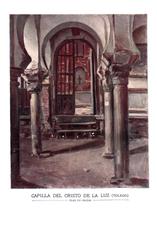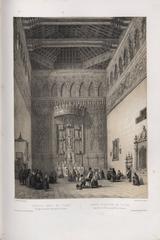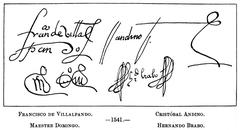Church of St Just and St Rufina, Toledo, Spain: Visiting Hours, Tickets, and Historical Significance
Date: 04/07/2025
Introduction
In the heart of Toledo’s historic center, the Church of St Just and St Rufina (Iglesia de las Santas Justa y Rufina) stands as a remarkable testament to the city’s complex religious and cultural heritage. This monument not only showcases a fascinating blend of Mudéjar, Mozarabic, Gothic, Renaissance, and Baroque styles, but also encapsulates centuries of Christian, Muslim, and Jewish coexistence. Originally established soon after King Alfonso VI’s reconquest in the 11th century, the church honors Saints Justa and Rufina—early Christian martyrs whose legacy continues to resonate in Toledo’s spiritual life. Today, the church serves both as an active parish and as a captivating destination for architecture enthusiasts, history lovers, and travelers seeking meaningful cultural experiences (Toledo Tourism Office, Wikipedia).
This guide offers a detailed exploration of the church’s historical evolution, architectural highlights, visiting information, travel tips, and nearby attractions to help you get the most from your visit.
Historical Overview
Origins and Foundation
Founded shortly after 1085 as Christian rule returned to Toledo, the Church of St Just and St Rufina is one of the city’s oldest parishes. Its dedication to Saints Justa and Rufina—martyred in 304 CE—reflects an effort to reinforce Christian identity after centuries of Muslim governance (cultura.castillalamancha.es). The church’s location and early structure suggest it may have supplanted a mosque, as evidenced by the integration of Islamic architectural elements (Wikipedia).
Architectural Evolution
Mudéjar and Mozarabic Foundations
The church’s earliest elements, notably its brick apse with blind arches and geometric patterns, are distinctive of Mudéjar architecture—a style blending Islamic artistry with Christian building traditions. Mozarabic influences are also present, notably in horseshoe arches and certain stonework, reflecting the Christian communities that lived under Muslim rule (Evendo).
Gothic, Renaissance, and Baroque Developments
Subsequent centuries saw Gothic chapels added and the incorporation of Renaissance features by architect Alonso de Covarrubias in the 16th century. The 18th-century Baroque renovation transformed the church’s interior with painted walls and elaborate altarpieces, while the exterior received a trompe l’oeil brick effect and a new tower-portal entrance (cultura.castillalamancha.es).
Religious and Cultural Significance
Throughout its history, the church has been a focal point for local religious life, hosting regular Masses, sacraments, and community celebrations—especially on the feast day of Saints Justa and Rufina, July 19th. Its architecture mirrors Toledo’s “City of Three Cultures” identity, with Christian, Muslim, and Jewish influences woven into its very fabric (medium.com).
Notable Architectural and Artistic Features
Exterior Highlights
- Brick Apse & Blind Arches: Outstanding Mudéjar elements, possibly dating back to the 13th century.
- Horseshoe Arches: Mozarabic and Mudéjar features, reflecting Islamic influence.
- Islamic and Visigothic Spolia: A 10th-century Islamic arch fragment and a Visigothic pilaster embedded in the northwest façade (Wikipedia).
Interior Features
- Corpus Christi Chapel: Noted for its 14th-century Mudéjar wooden ceiling and colorful azulejos.
- Plateresque Ironwork: The Virgen de la Esperanza chapel features an exquisite Renaissance ironwork screen.
- Altarpieces and Paintings: Baroque altarpieces and polychrome woodwork, with artwork depicting the lives of the patron saints.
- Light and Atmosphere: Subtle natural light enhances the contemplative ambiance of the nave.
- Restoration Discoveries: Recent conservation efforts revealed hidden wall paintings and preserved medieval elements (toledoolvidado.blogspot.com).
Visiting Information
Location and Access
- Address: Calle de San Justo, 4, Toledo, Spain.
- Getting There: Centrally located, within walking distance of the Cathedral, Jewish Quarter, and major city attractions. Closest parking at Miradero and Corralillo de San Miguel.
Visiting Hours (as of July 2025)
- Monday to Saturday: 10:00 AM – 6:00 PM
- Sundays and Religious Holidays: 12:00 PM – 6:00 PM
- Note: Hours may vary during religious services or special events; check updates on the official tourism website.
Tickets and Admission
- Standard Admission: €3
- Free Entry: Children under 10, Toledo residents, and during certain religious services
- Toledo Tourist Bracelet: Approximately €12; includes access to several monuments (official site)
Accessibility
- Mobility: Street-level entrance; some interior steps may pose challenges. Limited wheelchair access; inquire locally for details.
Visitor Guidelines
- Dress: Modest attire required (shoulders and knees covered).
- Photography: Permitted without flash; restrictions may apply during services.
- Facilities: Restrooms not available inside; nearby cafés and the tourist office offer facilities.
Tips and Recommendations
- Best Times to Visit: Early mornings or late afternoons for a quieter experience.
- Feast Day (July 19): Witness local traditions, but expect limited tourist access during ceremonies.
- Combine with Other Sights: The church is near the Toledo Cathedral, Jewish Quarter, and Alcázar—ideal for a walking tour.
- Guided Tours: Available through local operators or by request; enrich your visit with historical context.
Frequently Asked Questions (FAQs)
Q: What are the opening hours?
A: Monday–Saturday, 10:00 AM–6:00 PM; Sundays and holidays, 12:00 PM–6:00 PM. Hours may change during religious services.
Q: How much is admission?
A: €3; free for children under 10 and locals. The site is included in the Toledo Tourist Bracelet.
Q: Are guided tours available?
A: Yes, through local operators or at the church upon request.
Q: Is the church accessible?
A: Entrance is at street level, but some interior areas have steps or uneven floors.
Q: Can I take photos inside?
A: Photography is allowed without flash, except during services.
Nearby Attractions
- Toledo Cathedral: One of Spain’s greatest Gothic cathedrals, just a 5-minute walk away (The Tour Guy).
- Jewish Quarter: Including the Synagogue of Santa María la Blanca and the Sephardic Museum.
- Alcázar: An iconic fortress and military museum.
- El Greco Museum & Santo Tomé Church: Explore Toledo’s artistic legacy.
Visuals and Media
- Photos: Look for images highlighting the Mudéjar apse, Corpus Christi Chapel ceiling, and Plateresque ironwork.
- Maps: Use digital maps or official tourism resources to locate the church and plan your visit.
- Virtual Tours: Some tourism websites offer 360° virtual tours for remote exploration.
Summary and Final Tips
The Church of St Just and St Rufina is a living monument to Toledo’s religious devotion, artistic innovation, and multicultural legacy. With distinctive Mudéjar brickwork, Renaissance craftsmanship, and Baroque artistic flourishes, it stands out among Spain’s historic churches. Visitors are encouraged to:
- Plan around posted visiting hours and check for special events or closures.
- Take advantage of guided tours for deeper insight.
- Dress modestly and respect the church’s active parish role.
- Use the Toledo Tourist Bracelet for convenient multi-site access.
- Extend your visit to nearby landmarks to fully appreciate Toledo’s heritage.
Explore with curiosity, and let the Church of St Just and St Rufina deepen your understanding of Toledo’s unique identity as the “City of Three Cultures.”
Official Sources and Further Reading
- Official Cultural Heritage Listing (cultura.castillalamancha.es)
- Wikipedia: Church of St Just and St Rufina, Toledo
- Toledo: City of Three Cultures (medium.com)
- Toledo’s Must-See Monuments (toledospain.click)
- Evendo: Parroquia Mozárabe de las Santas Justa y Rufina
- Toledo Travel Guide
- The Tour Guy: How to See Toledo in a Day
- Toledo Guide: Tickets and Itineraries (atickettotakeoff.com)
